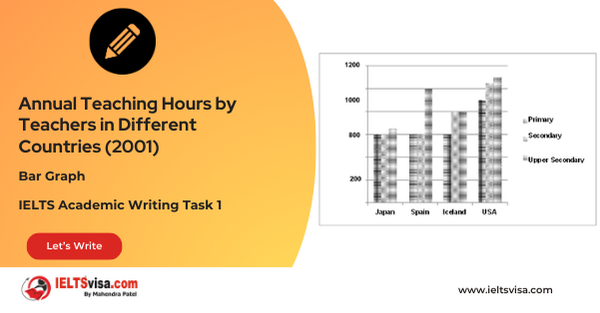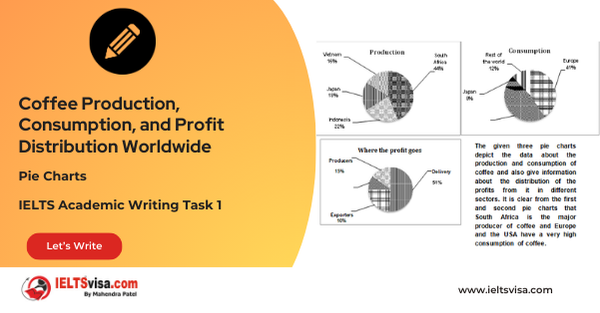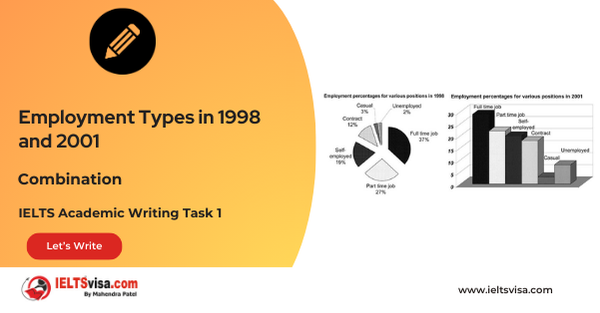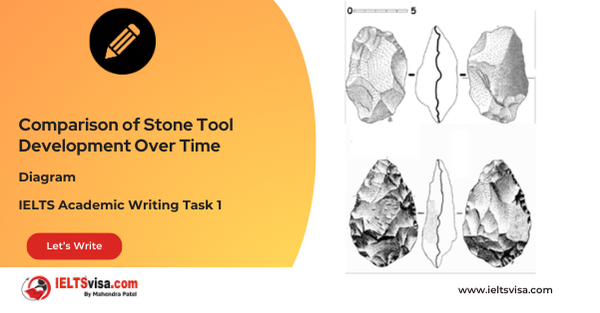Employment Rates of Men and Women Aged 60-64 in Four Countries (1970 and 2000)
IELTS Academic Writing Task 1 - Combination : Bar Graph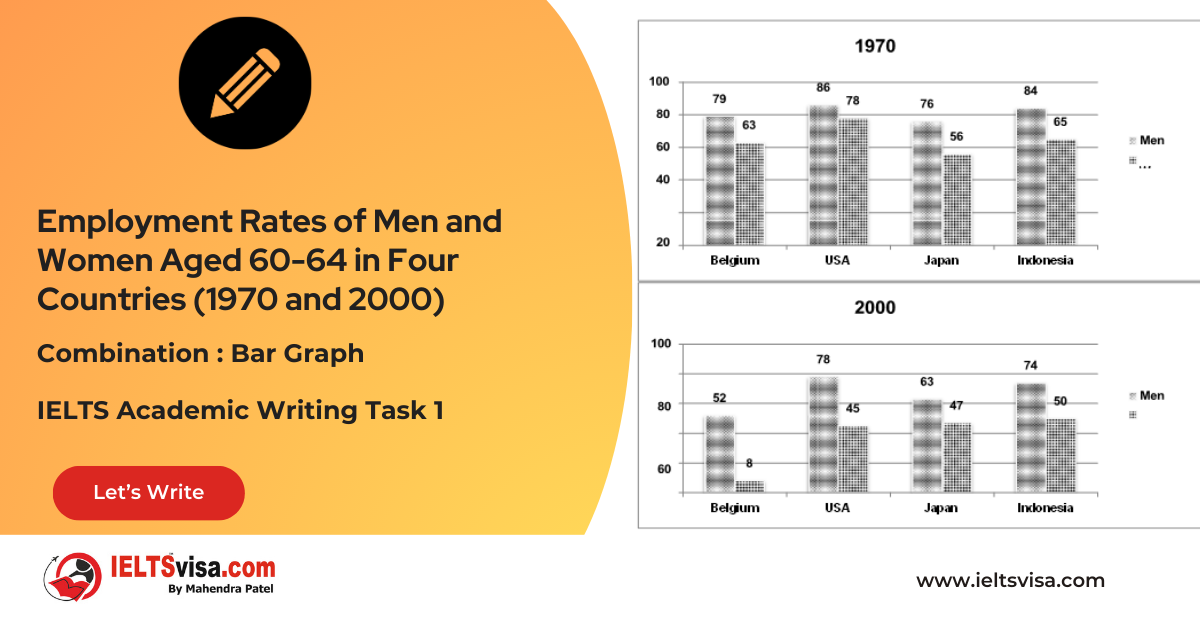
IELTS Writing Task 1 Question
The graphs below show the percentage of men and women aged 60-64 who were employed in four countries in 1970 and 2000.
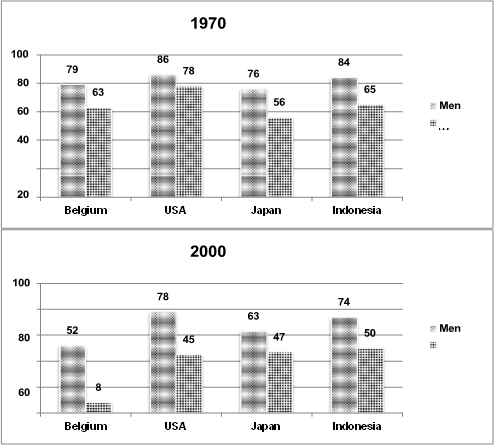
Common questions for the employment graph
1. Graph Type: Column graph (bar chart).
2. Title: Employment Rates of Men and Women Aged 60-64 in Four Countries (1970 and 2000)
3. What are the units of measurement?: Percentage of employed men and women aged 60-64.
4. Who: The data compares employment rates among men and women aged 60-64 in four countries: Belgium, the USA, Japan, and Indonesia.
5. When: The data spans two years, 1970 and 2000.
6. Where: The countries being compared are Belgium, the USA, Japan, and Indonesia.
7. Topic: The graph shows changes in employment rates for men and women aged 60-64 in four countries across a 30-year period.
Process Showing and Trends
Comparison 1: Employment Rates in 1970
- The USA had the highest employment rates for both men (86%) and women (78%) in 1970. Indonesia followed closely behind, with 84% of men and 65% of women employed. In Belgium, 79% of men and 64% of women were working. Japan had the lowest rates, with 76% of men and 56% of women employed.
Comparison 2 : Employment Rates in 2000
- By 2000, employment rates for both men and women had decreased in all four countries. The USA saw a decrease of 8% for men and 33% for women. Indonesia experienced a decline of 10% for men and 15% for women. In Japan, the percentage of employed men dropped by 13%, while the decrease for women was 9%. Belgium faced the steepest drop, with 27% fewer men employed and a dramatic 55% drop in the number of women employed.
Comparison 3 : Gender Differences
- In 1970, men consistently had higher employment rates than women across all countries. This trend remained in 2000, although the gender gap had widened in some countries, especially in Belgium and the USA, where women’s employment decreased significantly.
Sample Answer
The given column graphs compare the percentages of employed men and women aged 60-64 in four countries (Belgium, the USA, Japan, and Indonesia) in 1970 and 2000.
In 1970, the USA had the highest employment rates for both men (86%) and women (78%). Indonesia followed, with 84% of men and 65% of women employed. Belgium had 79% of men and 64% of women working, while Japan had the lowest rates, with 76% of men and 56% of women employed.
By 2000, employment rates had dropped in all countries. In the USA, the employment rate for men fell by 8%, and for women, it decreased by 33%. Indonesia saw a decrease of 10% for men and 15% for women. Japan’s figures dropped by 13% for men and 9% for women. Belgium experienced the most significant decline, with 27% fewer men employed and a massive 55% decrease in the number of employed women.
Overall, the data shows that the year 2000 marked a period of economic downturn, with the most substantial impact on employment rates among women, particularly in Belgium and the USA.
Top 26 Vocabularies
| Vocabulary | Meaning | Synonyms | Examples | Type |
| Brunt | The main force or impact | Impact, weight | “The biggest brunt of the recession was faced by Belgian women, with a 55% decrease in employment.” | Noun |
| Decline | A decrease or reduction | Decrease, drop | “By 2000, the percentage of employed men and women declined in all four countries.” | Noun |
| Recession | A period of economic decline | Downturn, slump | “The year 2000 witnessed a period of recession in all the four countries.” | Noun |
| Dramatic | Sudden and extreme | Striking, significant | “Belgium faced the steepest dramatic drop in the number of employed women, with a 55% decrease.” | Adjective |
| Widened | To become broader or more extensive | Expanded, increased | “The gender gap in employment widened in the USA and Belgium in 2000.” | Verb |
| Comparison | The act of analyzing differences or similarities | Contrast, juxtaposition | “The comparison of employment rates between the countries highlights distinct patterns.” | Noun |
| Decreased | Became smaller or less | Reduced, diminished | “By 2000, the employment rate for women decreased significantly in Belgium.” | Verb |
| Employment | The state of having a job or being employed | Work, occupation | “Employment rates were high in the USA in 1970 but dropped by 2000.” | Noun |
| Decline | A downward trend or reduction in number or quality | Decrease, drop | “The overall employment decline was more noticeable for women.” | Noun/Verb |
| Diminished | Became smaller or weaker | Decreased, reduced | “Japan’s employment rates diminished for both genders by 2000.” | Verb |
| Significant | Important or meaningful in size or effect | Noteworthy, considerable | “Belgium saw a significant decline in the employment of women.” | Adjective |
| Drop | A reduction or fall in amount or quality | Decline, decrease | “There was a noticeable drop in women’s employment in Belgium.” | Noun/Verb |
| Gender gap | The difference between men and women in terms of access, opportunities, etc. | Gender disparity, difference | “The gender gap in employment grew in Belgium and the USA by 2000.” | Noun |
| Substantial | Large in amount, degree, or importance | Considerable, significant | “The USA experienced a substantial decrease in women’s employment rates.” | Adjective |
| Impact | The effect or influence of one thing on another | Effect, consequence | “The economic downturn had a considerable impact on women’s employment.” | Noun |
| Economic downturn | A period when economic activity is slowing or declining | Recession, slump | “The year 2000 marked an economic downturn in all four countries.” | Noun |
| Recession | A period of economic decline, typically lasting for months or years | Downturn, contraction | “The recession affected the employment rates for both genders in all countries.” | Noun |
| Fluctuation | Irregular changes or variations | Variation, oscillation | “There were fluctuations in the employment rates in all four countries.” | Noun |
| Workforce | The group of people engaged in work or employment | Employees, labor force | “The decline in workforce participation was particularly evident among women.” | Noun |
| Observations | Statements or conclusions based on data or analysis | Findings, remarks | “The observations highlight that women were most affected by employment declines.” | Noun |
| High | Above the average or standard level | Elevated, prominent | “In 1970, the USA had the highest employment rates for both men and women.” | Adjective |
| Lowest | The smallest or least in amount, degree, or quality | Smallest, bottom | “Japan had the lowest employment rates among the four countries in 1970.” | Adjective |
| Affect | To influence or make an impact on something | Influence, change | “The recession greatly affected employment rates in all countries.” | Verb |
| Marked | Clearly noticeable or significant | Pronounced, noticeable | “Belgium experienced a marked drop in women’s employment.” | Adjective |
| Significance | The quality of being important or meaningful | Importance, weight | “The significance of the employment drop in Belgium cannot be overstated.” | Noun |

Our Books
Master IELTS Speaking Part 1
IELTS Writing Task 1 Book
IELTS Writing Task 2 Book
Practice IELTS Other Modules
IELTS Listening
The IELTS Listening test assesses how well you can understand spoken English in various contexts. It lasts about 30 minutes and is divided into four sections with a total of 40 questions. The listening tasks become increasingly difficult as the test progresses.
IELTS Academic Reading
The IELTS Academic Reading section assesses your ability to understand and interpret a variety of texts in academic settings. It is designed to evaluate a range of reading skills, including skimming for gist, reading for main ideas, reading for detail, understanding inferences, and recognizing a writer's opinions and arguments.
IELTS Speaking
The IELTS Speaking test assesses your ability to communicate in English on everyday topics. It lasts 11-14 minutes and consists of three parts: introduction, cue card, and a discussion based on the cue card topic.
IELTS General Reading
IELTS General Reading tests your ability to understand and interpret various types of texts. Here are some key areas and types of content you can expect to encounter in the reading section, along with tips for effective preparation.
IELTS Academic Writing Task 1
In IELTS Academic Writing Task 1, you are presented with a visual representation of information, such as graphs, charts, tables, or diagrams, and you are required to summarize, compare, or explain the data in your own words.
IELTS General Writing Task 1
In IELTS General Writing Task 1, you are required to write a letter based on a given situation. The letter can be formal, semi-formal, or informal, depending on the prompt. Here’s a breakdown of the key components to include in your letter
IELTS Academic Writing Task 2
In IELTS Academic Writing Task 2, you are required to write an essay in response to a question or topic. Here’s a guide to help you understand the essential elements of this task
IELTS Exam Tips
To succeed in the IELTS exam, practice regularly, familiarize yourself with the test format, improve your vocabulary, develop time management skills, and take mock tests to build confidence.
Grammer for IELTS
Grammar is the foundation of effective communication in English. Understanding tense usage, subject-verb agreement, and sentence structure enhances clarity and coherence in writing and speaking.
Vocabulary for IELTS
Vocabulary plays a crucial role in the IELTS (International English Language Testing System) exam, especially in the Speaking and Writing sections. Here’s an overview of why vocabulary is important and how it impacts your performance
RECENT IELTS SAMPLES QUESTIONS AND ANSWERS
Task 1 – Column graph – Percentage of Young People Enrolled in Universities in 2000 and 2007.
20:00 Start Pause Stop [df_adh_heading title_infix="IELTS Writing Task 1 Question" use_divider="on"...
Task 1 – Bar Graph – Annual Teaching Hours by Teachers in Different Countries (2001)
20:00 Start Pause Stop [df_adh_heading title_infix="IELTS Writing Task 1 Question" use_divider="on"...
Task 1 – Pie Charts – Coffee Production, Consumption, and Profit Distribution Worldwide
20:00 Start Pause Stop [df_adh_heading title_infix="IELTS Writing Task 1 Question" use_divider="on"...
Task 1 – Column graph – Types of Transport Used by Tourists Visiting New Zealand from Five Countries in 2004.
20:00 Start Pause Stop [df_adh_heading title_infix="IELTS Writing Task 1 Question" use_divider="on"...
Task 1 – Bar and Pie Chart Combination – Employment Types in 1998 and 2001
20:00 Start Pause Stop [df_adh_heading title_infix="IELTS Writing Task 1 Question" use_divider="on"...
Task 1 – Diagram – Comparison of Stone Tool Development Over Time
20:00 Start Pause Stop [df_adh_heading title_infix="IELTS Writing Task 1 Question" use_divider="on"...


